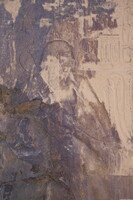Colossi of Memnon
unknown (Egyptian (ancient))

Download1A3-EG-T-CM-B13_cp.jpg (545.0Kb)
Alternative Title
Colossi of Amenophis III
Date
-1391--1353Description
The south statue of Amenhotep III, detail of the throne panel, showing the "sema-tawy" motif (Nile gods winding the papyrus and lily - symbols of Lower and Upper Egypt - around the hieroglyph for "unite", a common motif); Pair of colossal statues of Amenophis III [also known as Amenhotep III, reigned ca. 1391-1353 BCE] erected to flank the entrance to his monumental mortuary temple, today in the cultivated area of the Theban west bank. Little of the temple itself remains, since its sandstone elements were appropriated by Ramesses III for the construction of the Temple of Khons in the Karnak temple complex . Each monolithic quartzite colossus measures approximately 16 m in height and depicts Amenophis III seated on a blocklike throne. The King's mother, Mutemwia, and his principal queen, Tiye, both depicted on a much smaller scale, flank his calves. A princess once stood between them, but her identification is problematic, since the figure has been defaced and the inscriptions have been damaged. The source of the stone is still disputed-it may have been brought from a quarry at Aswan 200 km to the south or from Gebel el-Ahmar 700 km to the north. The name 'Colossi of Memnon' derives from the Greek identification of the northern statue as a depiction of the Trojan hero and Ethiopian king, Memnon, whose name sounded similar to one of the names of Amenophis III. Latin and Greek inscriptions on the feet and lower legs of this statue document early tourism in Upper Egypt. The fame of the site arose from the 'singing of Memnon', a sound produced by dew evaporating through a fissure in the stone of this colossus. Visitors' graffiti described the sound as Memnon's hymn to his mother Eos, the dawn. Restoration work, however, under the Roman emperor Septimius Severus (reigned 193-211 CE), sealed the fissure and the 'singing' ceased. Source: Grove Art Online; http://www.groveart.com/ (accessed 1/15/2008)
Type of Work
monument; sculpture (visual work)Subject
rulers and leaders, Amenhotep III, King of Egypt, New Kingdom (Egyptian), Eighteenth Dynasty
Rights
Rights Statement
Licensed for educational and research use by the MIT community only